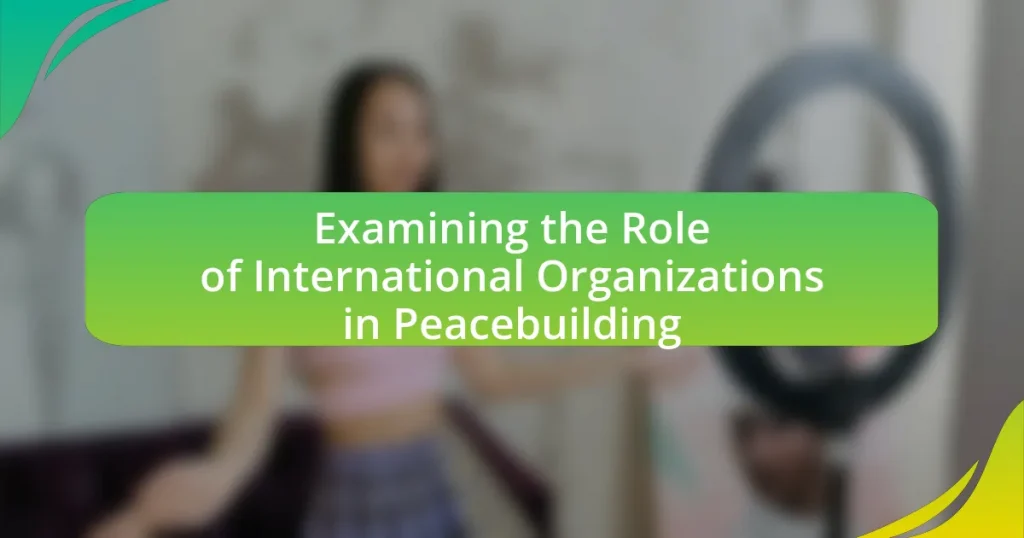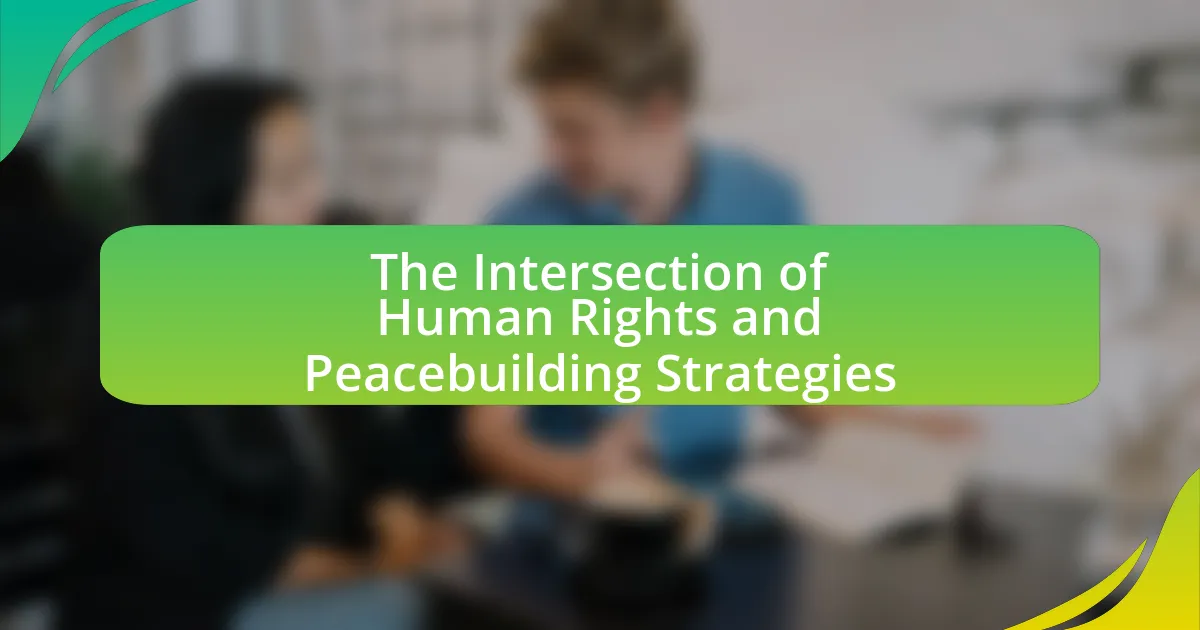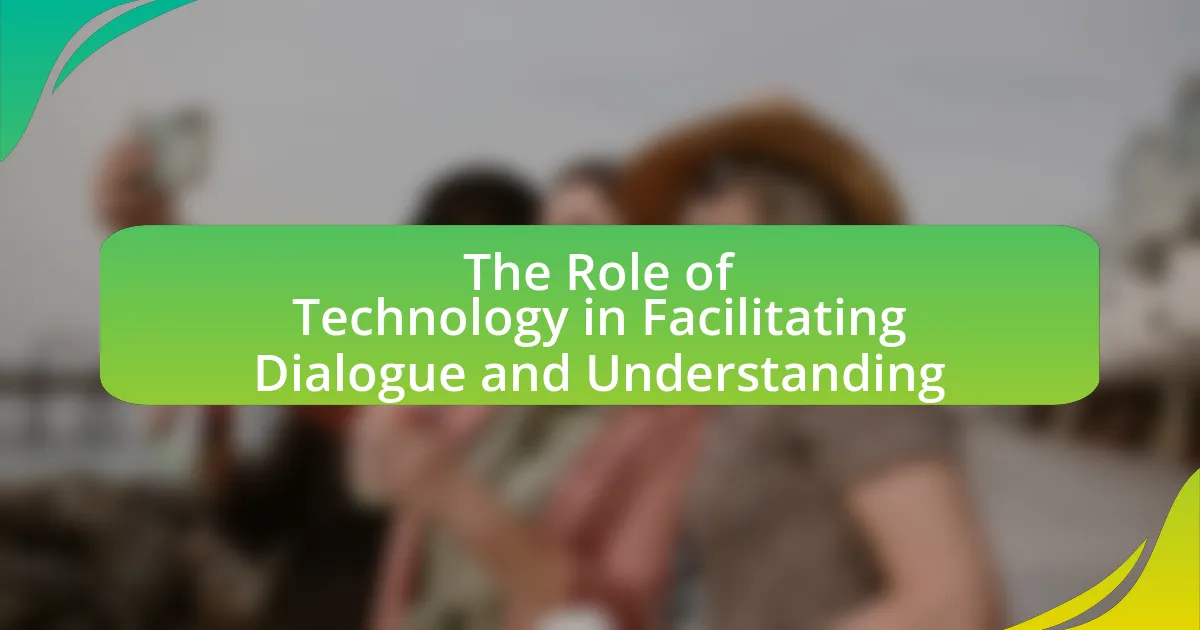International organizations, such as the United Nations, African Union, and European Union, play a vital role in peacebuilding by facilitating dialogue, providing resources, and coordinating conflict resolution efforts. They engage in mediation, peacekeeping missions, and post-conflict reconstruction, addressing the root causes of conflicts through comprehensive analysis and targeted interventions. The article examines the mechanisms these organizations use to foster cooperation, the importance of local community engagement, and the challenges faced by non-governmental organizations in peacebuilding initiatives. Additionally, it highlights best practices and lessons learned from past efforts, emphasizing the need for inclusive approaches and long-term commitment to achieve sustainable peace.
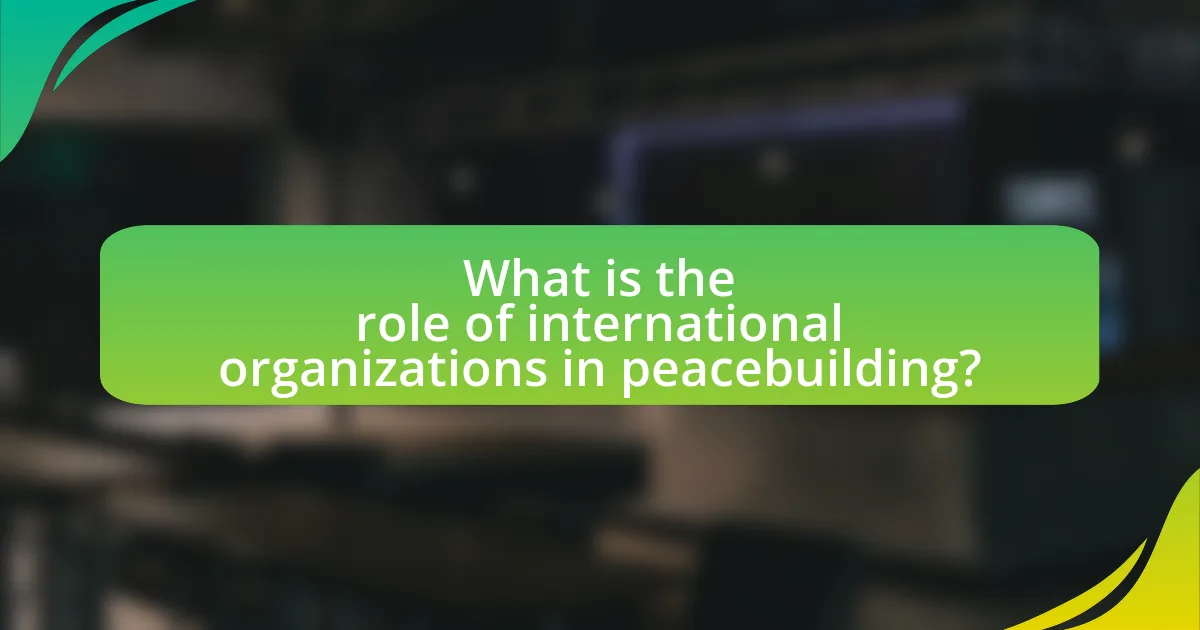
What is the role of international organizations in peacebuilding?
International organizations play a crucial role in peacebuilding by facilitating dialogue, providing resources, and coordinating efforts among various stakeholders. They engage in conflict prevention, mediation, and post-conflict reconstruction, often deploying peacekeeping missions to stabilize regions affected by violence. For instance, the United Nations has been instrumental in peacebuilding initiatives, with over 70 peacekeeping operations since 1948, which have contributed to reducing hostilities and fostering political solutions in conflict zones. Additionally, organizations like the African Union and the European Union have developed frameworks for conflict resolution and peacebuilding, emphasizing regional cooperation and capacity building. These efforts are supported by funding, expertise, and legitimacy that international organizations bring to the peacebuilding process, enhancing the chances of sustainable peace.
How do international organizations contribute to conflict resolution?
International organizations contribute to conflict resolution by facilitating dialogue, providing mediation services, and deploying peacekeeping forces. For instance, the United Nations has played a crucial role in mediating peace agreements, such as the Dayton Accords that ended the Bosnian War in 1995. Additionally, organizations like the African Union have engaged in conflict resolution efforts in regions such as Sudan and South Sudan, demonstrating their capacity to address and mitigate conflicts through diplomatic channels and on-the-ground interventions. These actions are supported by frameworks established in international law, which empower these organizations to intervene in disputes and promote peace.
What mechanisms do they use to facilitate dialogue between conflicting parties?
International organizations facilitate dialogue between conflicting parties through mediation, negotiation, and confidence-building measures. Mediation involves a neutral third party helping to bridge gaps between conflicting sides, as seen in the United Nations’ role in various peace processes, such as the mediation efforts in the Syrian conflict. Negotiation processes are structured dialogues aimed at reaching agreements, exemplified by the peace talks facilitated by the Organization of American States in Central America. Confidence-building measures, such as joint workshops and exchanges, promote trust and understanding, as demonstrated by the European Union’s initiatives in the Balkans. These mechanisms are essential for creating a conducive environment for lasting peace and resolution of conflicts.
How do they assess and address the root causes of conflicts?
International organizations assess and address the root causes of conflicts through comprehensive analysis and targeted interventions. They utilize conflict assessment frameworks that include data collection, stakeholder interviews, and analysis of socio-economic and political factors contributing to instability. For instance, the United Nations often employs tools like the Conflict Analysis Framework, which helps identify underlying grievances such as inequality, governance issues, and resource scarcity. By addressing these root causes through initiatives like economic development programs, governance reforms, and dialogue facilitation, international organizations aim to create sustainable peace. Evidence of effectiveness can be seen in post-conflict recovery efforts in countries like Rwanda, where targeted interventions led to significant improvements in stability and governance.
Why are international organizations essential for sustainable peace?
International organizations are essential for sustainable peace because they facilitate cooperation, dialogue, and conflict resolution among nations. These organizations, such as the United Nations, provide a platform for member states to engage in diplomacy, share resources, and implement peacekeeping missions. For instance, the UN’s peacekeeping operations have been deployed in various conflict zones, contributing to stability and the prevention of violence, as evidenced by the successful missions in Liberia and Sierra Leone, which helped restore order and promote democratic governance. By fostering international norms and frameworks, these organizations also help to address the root causes of conflict, thereby promoting long-term peace and security.
What long-term strategies do they implement to ensure stability?
International organizations implement long-term strategies such as fostering inclusive governance, promoting economic development, and facilitating conflict resolution to ensure stability. These strategies are designed to address the root causes of conflict and build resilient societies. For instance, inclusive governance encourages participation from diverse groups, which can reduce tensions and promote social cohesion. Economic development initiatives, such as job creation and infrastructure investment, help alleviate poverty and reduce the likelihood of conflict. Additionally, conflict resolution mechanisms, including mediation and dialogue facilitation, are essential for addressing disputes before they escalate into violence. These approaches have been validated by various studies, including the United Nations’ reports on peacebuilding, which highlight the importance of these strategies in achieving sustainable peace.
How do they engage local communities in the peacebuilding process?
International organizations engage local communities in the peacebuilding process by facilitating dialogue, promoting inclusive participation, and providing resources for conflict resolution. They often conduct community assessments to understand local needs and perspectives, ensuring that peacebuilding initiatives are culturally relevant and context-specific. For example, organizations like the United Nations Development Programme (UNDP) implement programs that empower local leaders and civil society groups, fostering grassroots involvement in decision-making. This approach is supported by evidence showing that peace agreements are more likely to be sustained when local communities are actively involved, as highlighted in the 2018 report by the United Nations Peacebuilding Support Office, which emphasizes the importance of local ownership in peace processes.
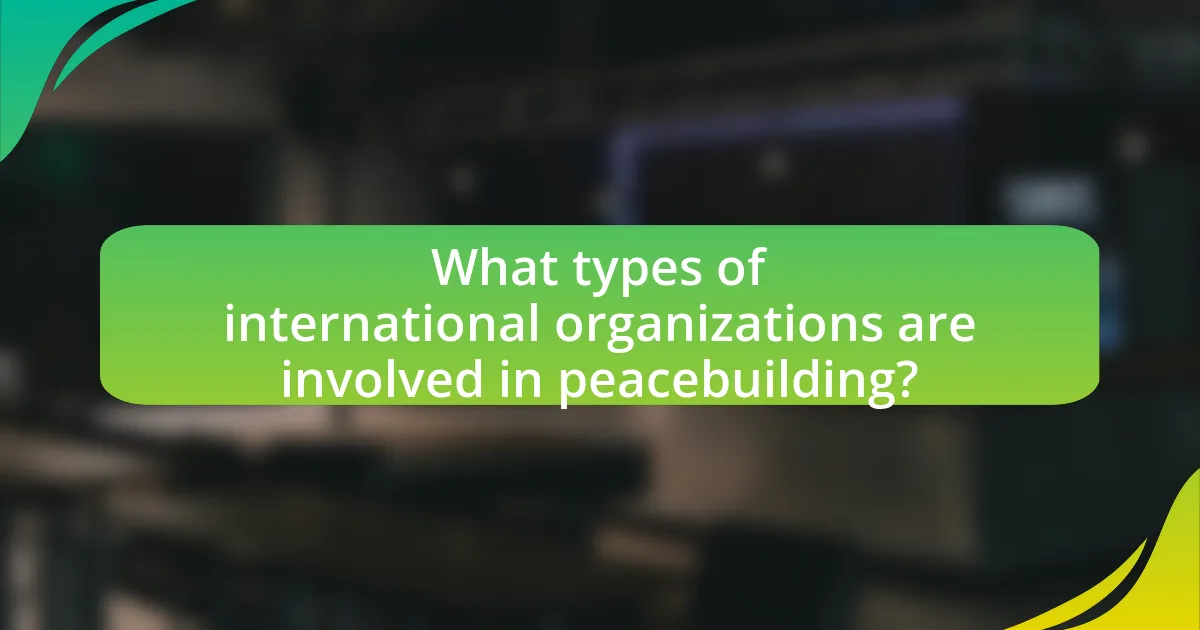
What types of international organizations are involved in peacebuilding?
International organizations involved in peacebuilding include the United Nations, regional organizations like the African Union and the European Union, and non-governmental organizations such as the International Crisis Group. The United Nations plays a central role through its peacekeeping missions and mediation efforts, while the African Union focuses on conflict resolution within Africa. The European Union engages in peacebuilding through its Common Security and Defence Policy. Non-governmental organizations contribute by providing on-the-ground support and advocacy for peace initiatives.
What roles do governmental organizations play in peacebuilding?
Governmental organizations play crucial roles in peacebuilding by facilitating diplomacy, providing humanitarian aid, and supporting post-conflict reconstruction. These organizations, such as the United Nations and regional bodies like the African Union, engage in conflict resolution through negotiations and peace agreements, which are essential for establishing lasting peace. For instance, the United Nations has been involved in over 70 peacekeeping missions since 1948, demonstrating its commitment to maintaining peace and security globally. Additionally, governmental organizations often coordinate international aid efforts, ensuring that resources are allocated effectively to support communities recovering from conflict, as seen in the aftermath of the 2011 Libyan civil war where various governments provided aid to stabilize the region. Furthermore, they assist in building governance structures and institutions that promote rule of law and human rights, which are vital for sustainable peace.
How do intergovernmental organizations like the UN contribute to peace efforts?
Intergovernmental organizations like the UN contribute to peace efforts primarily through conflict resolution, peacekeeping missions, and diplomatic mediation. The UN deploys peacekeeping forces to conflict zones, which have been instrumental in stabilizing regions post-conflict, as evidenced by successful missions in countries like Liberia and Sierra Leone. Additionally, the UN facilitates negotiations between conflicting parties, promoting dialogue and reconciliation, which has been crucial in peace processes such as the Colombian peace agreement. Furthermore, the UN provides a platform for international cooperation and consensus-building, enabling member states to address the root causes of conflict collectively.
What specific programs do they implement for peacebuilding?
International organizations implement various specific programs for peacebuilding, including conflict resolution training, community dialogue initiatives, and disarmament programs. For instance, the United Nations Development Programme (UNDP) focuses on strengthening governance and promoting social cohesion through its “Building Peaceful and Inclusive Societies” initiative, which aims to address the root causes of conflict. Additionally, the Organization for Security and Co-operation in Europe (OSCE) conducts programs that facilitate dialogue among conflicting parties and support democratic processes in post-conflict areas. These programs are designed to foster sustainable peace by addressing underlying issues and promoting reconciliation among communities.
What is the impact of non-governmental organizations on peacebuilding?
Non-governmental organizations (NGOs) significantly impact peacebuilding by facilitating dialogue, providing humanitarian aid, and promoting social justice. NGOs often act as intermediaries in conflict zones, fostering communication between conflicting parties and helping to build trust. For instance, organizations like the International Crisis Group have been instrumental in conflict resolution efforts by offering policy recommendations based on in-depth analysis of specific situations. Additionally, NGOs provide essential services such as education and healthcare, which can stabilize communities and reduce the likelihood of conflict. Research indicates that areas with active NGO involvement tend to experience lower levels of violence and greater community resilience, highlighting their crucial role in fostering sustainable peace.
How do NGOs complement the efforts of international organizations?
NGOs complement the efforts of international organizations by providing grassroots insights, mobilizing local communities, and implementing targeted programs that address specific needs. For instance, NGOs often have established relationships with local populations, which allows them to identify unique challenges and opportunities that larger organizations may overlook. This localized knowledge enhances the effectiveness of international initiatives, as seen in the collaboration between NGOs and the United Nations in humanitarian responses, where NGOs like Médecins Sans Frontières deliver medical aid in conflict zones, directly supporting UN efforts to stabilize regions. Additionally, NGOs can operate with greater flexibility and speed, enabling them to respond to urgent situations more rapidly than larger bureaucratic entities. This synergy between NGOs and international organizations ultimately leads to more comprehensive and effective peacebuilding strategies.
What challenges do NGOs face in peacebuilding initiatives?
NGOs face several challenges in peacebuilding initiatives, including limited funding, political instability, and cultural barriers. Limited funding restricts their ability to implement and sustain programs effectively, as many rely on donations and grants that may not be consistent. Political instability in conflict zones can hinder access to affected areas, making it difficult for NGOs to deliver aid and engage with local communities. Additionally, cultural barriers can lead to misunderstandings and resistance from local populations, complicating efforts to foster dialogue and reconciliation. These challenges are well-documented in reports from organizations such as the United Nations and various academic studies, which highlight the complexities NGOs encounter in their peacebuilding efforts.
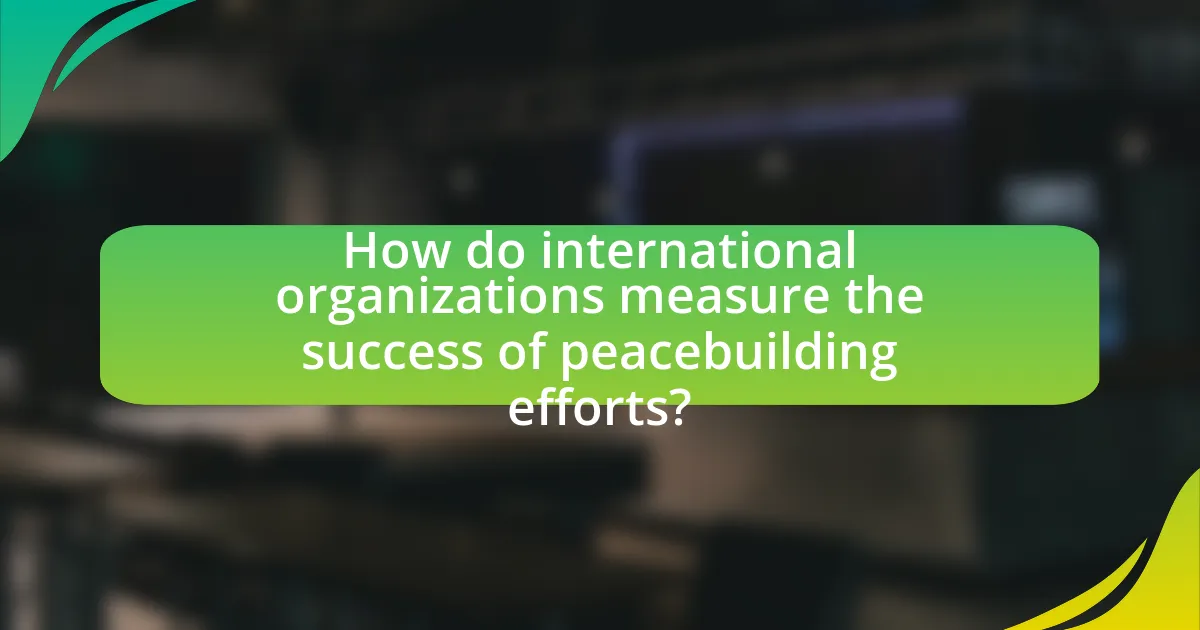
How do international organizations measure the success of peacebuilding efforts?
International organizations measure the success of peacebuilding efforts through a combination of quantitative and qualitative indicators. These indicators often include the reduction of violence, the establishment of stable governance structures, and improvements in social cohesion among communities. For instance, the United Nations uses specific metrics such as the number of violent incidents reported, the level of citizen participation in governance, and the effectiveness of local institutions to assess progress. Additionally, organizations may conduct surveys to gauge public perception of safety and trust in government, which provides insight into the societal impact of peacebuilding initiatives.
What indicators are used to evaluate peacebuilding outcomes?
Indicators used to evaluate peacebuilding outcomes include measures of social cohesion, levels of violence, and the effectiveness of governance. Social cohesion indicators assess community trust and relationships, while levels of violence are measured through crime rates and conflict incidents. Governance effectiveness is evaluated through the presence of rule of law, political stability, and public service delivery. These indicators are supported by frameworks such as the United Nations’ Sustainable Development Goals, which emphasize peace, justice, and strong institutions as essential components for sustainable development.
How do these indicators reflect the effectiveness of interventions?
Indicators reflect the effectiveness of interventions by providing measurable data that demonstrates changes in peacebuilding outcomes. For instance, a reduction in conflict-related deaths or an increase in community engagement can indicate successful intervention strategies. These indicators are often derived from systematic evaluations and assessments conducted by international organizations, such as the United Nations, which utilize specific metrics like the Global Peace Index to quantify peace levels. By analyzing these metrics, stakeholders can assess whether interventions lead to sustainable peace and stability, thereby validating the impact of their efforts in conflict-affected regions.
What role does data collection play in assessing peacebuilding success?
Data collection is essential in assessing peacebuilding success as it provides measurable indicators of progress and impact. By systematically gathering quantitative and qualitative data, organizations can evaluate the effectiveness of peace initiatives, identify areas needing improvement, and make informed decisions. For instance, the United Nations often utilizes surveys and conflict analysis reports to gauge community perceptions of safety and trust in institutions, which are critical metrics for understanding peacebuilding outcomes. This data-driven approach enables stakeholders to track changes over time, ensuring that interventions are responsive to the evolving context of conflict and peace.
What lessons have been learned from past peacebuilding initiatives?
Past peacebuilding initiatives have demonstrated the importance of local ownership and inclusivity in achieving sustainable peace. Successful initiatives, such as the 1995 Dayton Agreement in Bosnia, highlighted that involving local stakeholders in the peace process fosters greater commitment and accountability. Additionally, the failure of initiatives like the 2000 peace process in Sierra Leone illustrated that neglecting socio-economic factors can undermine peace efforts. Research shows that integrating economic development and addressing grievances significantly enhances the effectiveness of peacebuilding (Source: “The Role of Economic Development in Peacebuilding,” authors: John Paul Lederach and others).
How can these lessons inform future strategies for international organizations?
Lessons from past peacebuilding efforts can inform future strategies for international organizations by emphasizing the importance of local engagement and adaptability. For instance, successful interventions often involved collaboration with local communities, which enhanced trust and effectiveness, as seen in the United Nations’ peacekeeping missions in Sierra Leone, where local partnerships significantly contributed to stability. Additionally, these lessons highlight the necessity for flexible approaches that can respond to evolving contexts, demonstrated by the African Union’s adaptive strategies in conflict resolution across various nations. By integrating these insights, international organizations can enhance their operational frameworks, ensuring they are more responsive and effective in future peacebuilding initiatives.
What best practices have emerged from successful peacebuilding efforts?
Successful peacebuilding efforts have established several best practices, including inclusive dialogue, local ownership, and long-term commitment. Inclusive dialogue ensures that all stakeholders, including marginalized groups, are involved in the peace process, which fosters trust and legitimacy. Local ownership emphasizes empowering local communities to take charge of their peacebuilding initiatives, leading to more sustainable outcomes. Long-term commitment from international organizations and stakeholders is crucial, as it provides the necessary resources and support to address underlying issues and prevent relapse into conflict. These practices are supported by evidence from various peacebuilding case studies, such as the successful peace process in South Africa, which highlighted the importance of inclusivity and local engagement.
What practical steps can international organizations take to enhance their peacebuilding efforts?
International organizations can enhance their peacebuilding efforts by implementing inclusive dialogue processes that engage local communities and stakeholders. By facilitating participatory approaches, these organizations ensure that the voices of affected populations are heard, which fosters ownership and sustainability of peace initiatives. For instance, the United Nations has successfully employed this strategy in various post-conflict settings, such as in Liberia, where community engagement led to more effective reconciliation processes. Additionally, international organizations can strengthen their peacebuilding efforts by providing targeted training and resources to local peacebuilders, which builds local capacity and resilience. Research indicates that local ownership of peace processes significantly increases the likelihood of long-term stability, as seen in the case of the peacebuilding initiatives in Sierra Leone.
